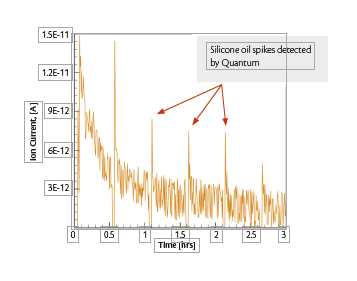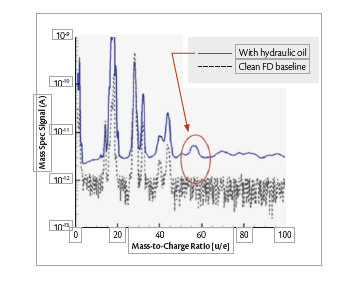
A molecular perspective in Freeze Drying with the Quantum Mass Spectrometer.
1. Mass Spectrometers: from an entire room to Quantum
The history of mass spectrometry can be traced back to the late 19< century at the time when the electron was first discovered. The application of mass spectrometers in freeze drying began with the first one being installed on an Edwards freeze dryer in the 1980s, standing almost as tall as the operator and taking up a lot of space. Since then, however, advanced miniaturization has allowed themass spectrometers to become compact, efficient and accurate. The Quantum mass spectrometer by IMA Life was developed partnering with Atonarp, a scientific instrumentation company and Pfizer. The Quantum mass spectrometer houses its own vacuum pumps, filament and sensors, requiring minimal external hardware.
2. Quantum Mass Spectrometer as a pat tool in Freeze-Drying
Numerous process analytical technologies are available to monitor the different stages in a freeze drying process. However, following the time intensive primary drying step, what usually follows is secondary drying, where very few sensors are available to provide information about the product and potentially about product quality.
Some freeze-dried products are non-aqueous solvent based, where it might be critical to increase temperatures for primary drying after all the solvent has flashed off to prevent product collapse or unaesthetic cakes.
Paraphrasing from FDA guidelines on the Freeze Drying process, it is necessary to monitor for leaks into the chamber that may originate from various sources such as the shelf thermal fluid, atmospheric system leaks and condenser coils.
Keeping in mind, these multi-dimensional aspects required from the next PAT tool, the Quantum mass spectrometer bridges gaps between reliable and usable sensors in an aseptic environment.

Fig 1
3. State of the art instrumentation
All instruments installed on freeze dryers need to be validated and calibrated. The Quantum mass spectrometer’s quick, reliable and long lasting calibration make it the perfect solution in its domain. It is factory calibrated against the gold standard capacitance manometer, with a known mixture of gases. The resonance frequency calibrations can be done at a customer site periodically by using ambient air as a calibration gas. The Quantum includes a built-in diagnostic tool – to determine the health of the system.
This feature ensures quick resolution of issues, should they occur.
All the parts on the Quantum mass spectrometer have a fairly long calibration and maintenance schedule. Regardless, the design of the Quantum mass spectrometer is such that all components can be serviced by removing just one panel of the housing assembly.
4. Applications in freeze drying production environments
This tool, the QMS has been tried and tested in lab as well as production environments. Specific Site Acceptance Tests (SATs) have been designed to test the performance and repeatability of measurements using the Quantum mass spectrometer.
The silicone oil detection cycle has been designed to look through the various shelf temperatures that a typical freeze dryer undergoes during a lyo cycle (figure 3). The detection level using the Quantum mass spectrometer has been proven down to 0.1 mg of silicone oil in a 1m3 pilot freeze dryer. In addition, this technology has been applied to detect and identify hydraulic oils (figure 4), which may potentially leak through the shelf or isolation valve rams into
a freeze dryer. The potential to detect and observe changes in composition of the aseptic environment open up a plethora of opportunities where the mass spectrometer is useful – for e.g. in determining whether the sterile environment has been broken when a vacuum pump fails, the oxygen concentration inside a freeze dryer will be scrutinized.
Residual Moisture at the end of the secondary drying step is a critical quality attribute for drug products. This parameter will determine protein stability as well as acceptance criteria for the batch. The Quantum mass spectrometer has the potential to predict the residual moisture in the lyophilized cake.

Fig 2

Fig 3

Fig 4
5. Looking ahead
As of August 2018, the Quantum has been installed at three major production sites within the US where standalone operations for contaminant detection is the primary objective. A major effort for integrating the Quantum software with a freeze dryer SCADA system is underway and the first four of such mass specs are expected to be in operation by mid-2019. The Quantum mass spectrometer’s usability is designed with the end-user in mind. Compact footprint housed on a cart in a standalone operation for easy helium leak detection. IP enclosure for a mechanical room installation. And a filter assembly to prolong sensor life are some of the many features that have made Quantum mass spectrometer the go-to solution for the freeze drying industry.
The R&D work on mass spectrometry continues at IMA Life, with current focus on determining the optimal port location for sampling trace quantities of gas species. Various Computational Fluid Dynamics simulations are being developed to complement the Quantum mass spectrometer’s detection capability. With the cost of a typical Lyo product cycle in 2018 ranging up to 10 million US dollars, the importance of batch monitoring is obvious. Through rigorous scientific experiments, successful installations and a clear path forward, the Quantum mass spectrometer is a comprehensive tool for the task at hand.
Paper sections:
Last Submitted papers:
- LYnfinity is just the drop away
- LYnfinity – Drying Technology
- Today, freeze dryer can use a 100% green refrigeration system, using air as the refrigeration fluid.
- DSMC simulations of vapor flow and ice dynamics in a freeze dryer condenser.
- Freeze-Drying Process Optimization.
- Increasing Vial to Vial Homogeneity: An Analysis of VERISEQ® Nucleation on Production Scale Freeze Dryers.
- Lynfinity – Freezing
- Lynfinity – Spraying

